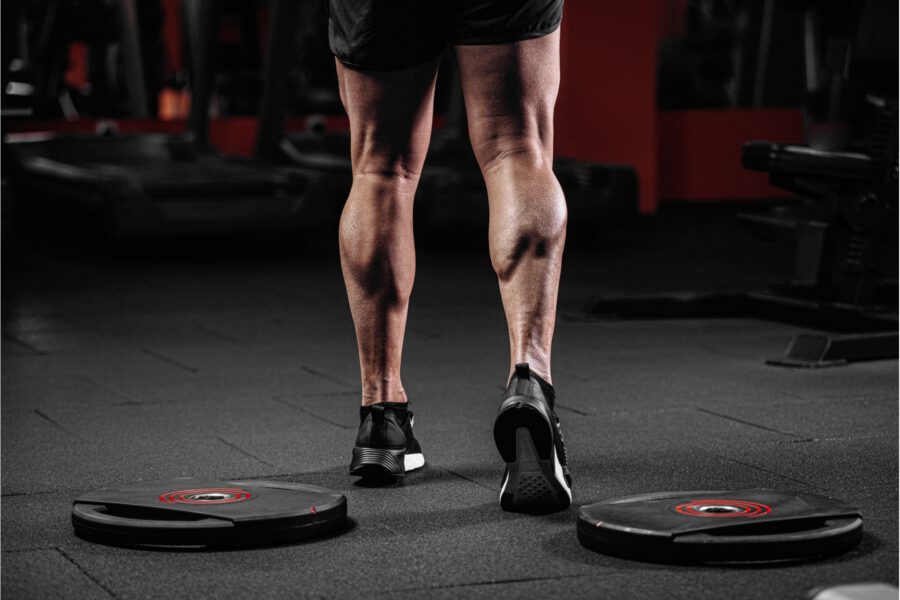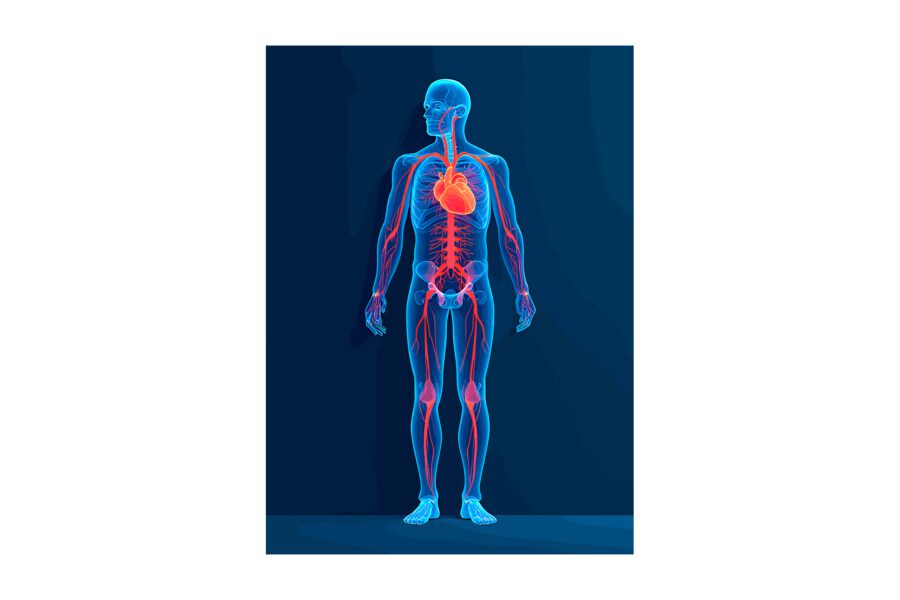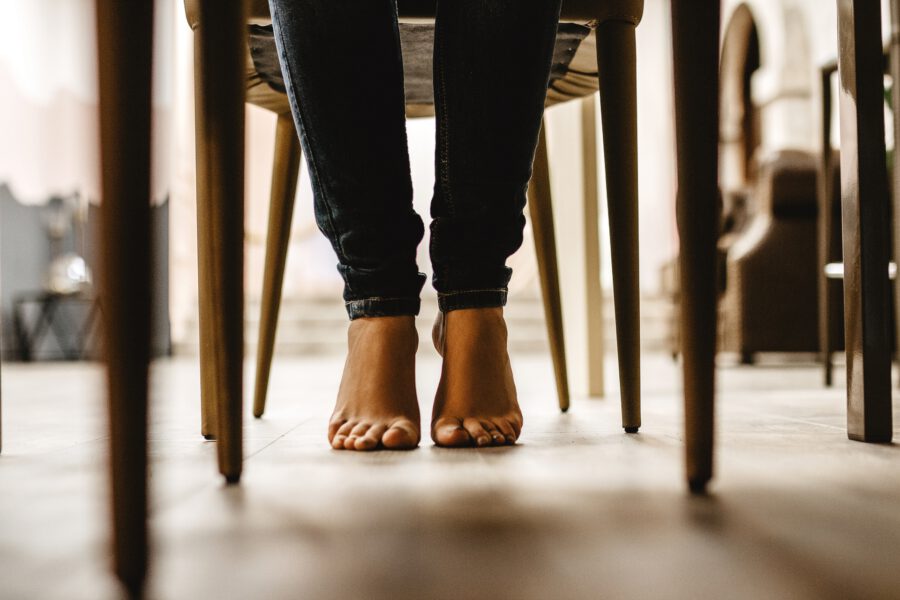Why Your Calf Muscles Are Called Your Second Heart
When you think about heart health and circulatory system, we immediately picture the chest and the rhythmic thump of the heart pumping blood throughout the body. But did you know that there is a medically accepted “second heart” in the body that acts the same way?
The calf muscles play a crucial role in keeping blood moving, especially from the lower extremities back toward the heart. Consider the challenge: blood that has traveled the farthest distance from the heart—down to your feet and legs—must be systematically pumped back to the heart and lungs to receive fresh oxygen and repeat the entire circulatory cycle. The calf muscles' pumping action serves as a vital mechanism that directly impacts both your health and longevity.
Unfortunately, the calf muscles are among the most neglected muscles to train in the gym. Men often focus so heavily on their upper body profile and building the V-taper body that they undertrain their calves, without realizing that beyond aesthetic reasons, strong calves can literally save their lives.
In this article, we will dive deeper as to why your calf is called the second heart and give you practical tips to take advantage of this fact to optimize your health and fitness.
Your cardiovascular system operates as a closed-loop network where your heart serves as the central pump, pushing oxygen-rich blood through arteries to every corner of your body. This arterial system works efficiently because it moves with the heart's powerful contractions and benefits from gravity when blood flows downward to your legs and feet.
However, the return journey presents a formidable challenge. Veins carrying deoxygenated blood back to the heart must work against gravity's relentless pull, especially from the lower extremities. Unlike arteries, veins have thinner walls and lower pressure, making this upward journey particularly demanding without additional assistance.
This is where your calf muscles become so valuable. Every time you take a step or flex your ankles, your calf muscles contract and squeeze the veins in your lower legs. This contraction pushes blood upward, against gravity, through a one-way valve system in the veins.
When the muscles relax, the valves close, preventing backflow. This pumping action mimics the role of the heart by actively pushing blood through the body, especially from the legs back up to the chest.
The calf muscles keep circulation efficient, especially in upright humans where gravity constantly works against upward blood flow.
Without the complex action of the calf muscle, blood will pool and “get stuck” in your lower legs, especially during long periods of standing or sitting.
When deoxigenated blood (blood cells that are not carrying oxygen) fails to return to the heart and recirculate, it can lead to swollen ankles, fatigue, sores, and fatal blood clots that can get dislodged and block the blood vessels of the heart, lungs or brain, causing heart attack or stroke.
By aiding the upward movement of blood, the calves reduce the pressure load on the heart. When the calf pump is active and healthy, the heart doesn’t have to work as hard to circulate blood throughout the body. This improves overall circulation and helps stabilize blood pressure. On the flip side, weak or inactive calf muscles can lead to higher cardiovascular strain and increased risk of circulatory disorders.
Studies show that calf circumference is inversely correlated with resting heart rate. This means that larger, stronger calf muscles are associated with a lower resting heart rate, which indicates more efficient heart function. This relationship is commonly observed in athletes, who typically have both well-developed calf muscles and highly efficient cardiovascular systems.
In short, your calves are doing much more than powering your stride. They’re a critical part of the system that keeps your blood moving and your heart supported.
Unfortunately, the rising cases of sedentary lifestyle put this innate function of the calf at risk. Daily habits have a direct and measurable impact on how well your calf pump system works. We are not just talking about exercising; It’s about movement patterns, postures, hydration and even footwear.
When you sit for long periods, especially with your knees bent at 90 degrees, the blood flow in your lower legs slows down dramatically. The calf muscles stay relaxed, meaning they aren’t contracting to push blood upward. This leads to venous stasis, where blood pools in the legs and ankles. Over time, this can cause swelling, varicose veins, and reduced oxygen delivery to tissues.
This is why people who sit at desks for hours or take long-haul flights are at higher risk of developing deep vein thrombosis (DVT). Without calf movement, the blood thickens and slows, increasing the likelihood of clot formation.
Here’s what you can do:
Set a timer to stand and move every 30–60 minutes. Even a short walk or a few standing calf raises at your desk can re-engage the calf pump and support circulation. Medically, it is advisable to stand and walk for 10-20 minutes every 2 hours that you are sitting.
Walking is one of the most natural ways to activate the calf pump. Each step causes a contraction and relaxation cycle in the calf muscles. When people live a low-movement lifestyle, their calves weaken, and the pumping action becomes less efficient. Over time, this can also reduce the tone and elasticity of the veins, further impairing circulation.
The less you walk, the more your cardiovascular system suffers from sluggish venous return. It’s a compounding effect—weak calves mean less movement of blood, which means more strain on the heart.
Here’s what you can do:
Aim for at least 7,000–10,000 steps a day with intentional walking. Include stairs, hills, or incline walking to naturally strengthen your calves and boost blood return. During your work days, try to squeeze in some lower body movement snacks to keep you active.
Here’s a workout routine for men that will grow more than just your calves:
Here’s a workout routine for women that will grow more than just your calves:
Another often overlooked factor is hydration. Dehydrated blood becomes thicker, increasing resistance in the veins. When combined with inactivity, this places extra stress on the calf pump. The muscles have to work harder to move more viscous blood, and the risk of clotting rises.
Hydration supports blood fluidity, allowing smoother movement through the narrow veins of the lower legs.
Here’s what you can do:
Drink water consistently throughout the day, not just during workouts. A good baseline is half your body weight (lbs) in ounces daily to keep blood flow smooth and efficient. Or you could just follow the usual tip of 8-10 glasses of water per day.
The type of footwear you use also plays a role. Shoes with elevated heels (including many modern sneakers or office shoes) shift your weight forward and reduce full extension of the ankle joint. This limits the range of motion of the calf muscles and restricts how much force they can generate during walking.
In contrast, barefoot-style shoes or walking barefoot (on appropriate surfaces) allow the ankles and calves to move through their full range, maximizing pump efficiency.
Here’s what you can do:
Choose footwear that allows natural ankle mobility and doesn't overly restrict your gait. When safe, spend time walking barefoot or using minimalist shoes to fully activate your calves.
Standing still for long periods may seem better than sitting, but it can also reduce calf pump efficiency. If your calves are not actively contracting, such as when you stand motionless, blood can still pool in the lower legs. This is especially common for workers in retail, factory floors, or security.
The key is movement. Shifting your weight, performing calf raises, or simply walking for a minute or two can reactivate the pump and keep circulation healthy.
Here’s what you can do:
If your job requires standing, make a habit of shifting your weight, performing mini calf raises, or walking in place every 10–15 minutes. This keeps the calf pump working and prevents blood pooling.
The soleus push-up (SPU) is not your average calf raise.
It’s a low-intensity, high-frequency movement designed to activate the soleus muscle while you're seated. Unlike dynamic exercises that target large muscle groups, the SPU taps into the unique metabolic properties of the soleus to improve blood sugar regulation, fat metabolism, and circulatory health.
The soleus push-up is performed in a seated position, exactly how you position yourself when working at your desk. The goal is to push using the front part of your foot to lift your heel, then gently lower it back down, repeating this motion continuously. Its simplicity makes this exercise perfect for people who need to work at a desk for extended periods.
Multiple studies have detailed how performing soleus push-ups for 4-6 hours straight can significantly improve your sugar regulation and fat metabolism, even without changing your diet or performing additional exercises outside your usual routine.
Studies found that 130 minutes of SPUs burned at least 200 calories, while 270 minutes of sustained SPUs can burn as much as 400 calories. More importantly, SPUs also led to a reduction in bad cholesterol and preserved muscle strength in the calves of aging participants.
This is possible because the soleus muscle directly uses blood glucose (sugar-free flowing in the blood) and lipids (fats) directly for fuel without relying on glycogen stores. This makes it highly efficient at clearing blood sugar and fat even during low-intensity movement.
I know what you are thinking. Isn’t 4-6 hours of repeated soleus push-ups a bit too much and absurd? Here’s the key, The soleus muscle doesn’t fatigue easily because it’s made up of mostly slow-twitch, oxidative muscle fibers designed for endurance, not power.
Unlike other muscles, it uses a unique metabolic pathway that draws directly from blood glucose and fat, allowing it to work for hours without running out of energy or building up lactic acid. Since soleus push-ups are low-load and don’t cause muscle damage or soreness, they can be done for hours daily without soreness or fatigue.
Literally, strengthening your calf muscles leads to improvements in your cardiovascular health.
If you want to build a stronger and bigger calf muscle, add 3-4 calf exercises on your lower body exercises and splits.
Here are some of the best calf workouts to you can add to your routine:
Your calves are not just for aesthetics or explosive power. They are central to your circulation, metabolic health, and long-term well-being.
Prioritize calf training through consistent and deliberate movements. Train using compound lifts and bodyweight exercises that focus on lower body strength and growth. Add the soleus push-up to your routine, especially if you're bound to desk work.



